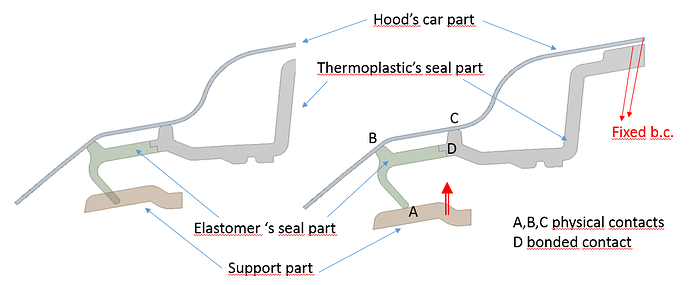I created a nonlinear static analysis of a compression hyperelastic rubber between two rigid bodies.
I have some problems with simualtion runs. I received this message EXECUTION_CODE_ASTER_EXIT_10=1 , what does mean?
Hi @jgonz,
I will have a look at that as soon as possible.
@rszoeke , any experiences about this issue?
Cheers,
Jousef
Hi @jgonz,
the message that you mentioned only means that an error happened (basically whenever the exit code is not equal to zero).
The actual error comes from the use of the bonded contact.
I’ll have a closer look why this error could actually happen.
In the meantime you can work around this by setting the position tolerance to off. In your case it won’t influence the results anyways.
If you re-run your analysis will proceed a little further but you will get a different error stating that you have some nodes common on multiple slave definitions of your physical contact. If you remove faceGroupOnGeoFaces_68 from the slave side of contact Connection 3 it should at least proceed to start with actually solving the system.
Best,
Richard
Hi @rszoeke, @jousefm
Thanks a lot for the quickly help!
I solved the problem with bonded contact and with the common nodes defined in multiple slave regions, but by now I’m still running into trouble with convergence : I’ve already updated some items, such as Tolerance of the convergence criteria (0.001 ), convergence criteria from relative to absolute, option “Stop if singular” made it false, i have also changed Initial time step length, i switched to Auto timestepping, i reduced the penalty coefficient. But unfortunately I still get an error after a while.
Any idea how to select the right values for the simulation setup?
Thx in advance
Hi @jgonz,
could you explain us please what your project is about? I am trying to understand what you are investigating because setting BC’s without knowing the purpose of your simulation is very vague 
Cheers,
Jousef
Hey @jgonz!
I managed to perform a quick analysis with your case. You can find it here: Rubber pressing analysis
I took only a portion of your model and assumed a plane strain condition along the sides (as if the original part was too long). This helped me to have a better mesh with faster simulation time. Please note that the second order mesh simulation with physical contact was hard to perform. In that case, please mind the changes I made to the original case in order to make it work.
Below you can find an animation of the second order results.
In case of any question, feel free to ask.
Best,
Ahmed
Hi @jousefm,
I am simulating a seal which is located between the hood’s car (upper part in the model) and the support part (lower part).
This seal is a bicomponent part, the first one is made from a TPV elastomer and the second one from a PP thermoplastic. I wanted to know how the seal deforms when the hood’s car is on closed position. For that position i only know the interference fit between the lower part and the lower lip of the seal. That’s solved in the model aplying a displacement at the lower part equivalent to that interference when these two parts are adjusted on.
Best,
Quim
Thx in advance !!!
I will check your model before asking you any doubt.
Best,
Quim
Hi @jgonz and thank you for the detailed description!
@ahmedhussain18 was faster than me  Let us know if the simulation by him is what you had in mind.
Let us know if the simulation by him is what you had in mind.
Cheers,
Jousef

